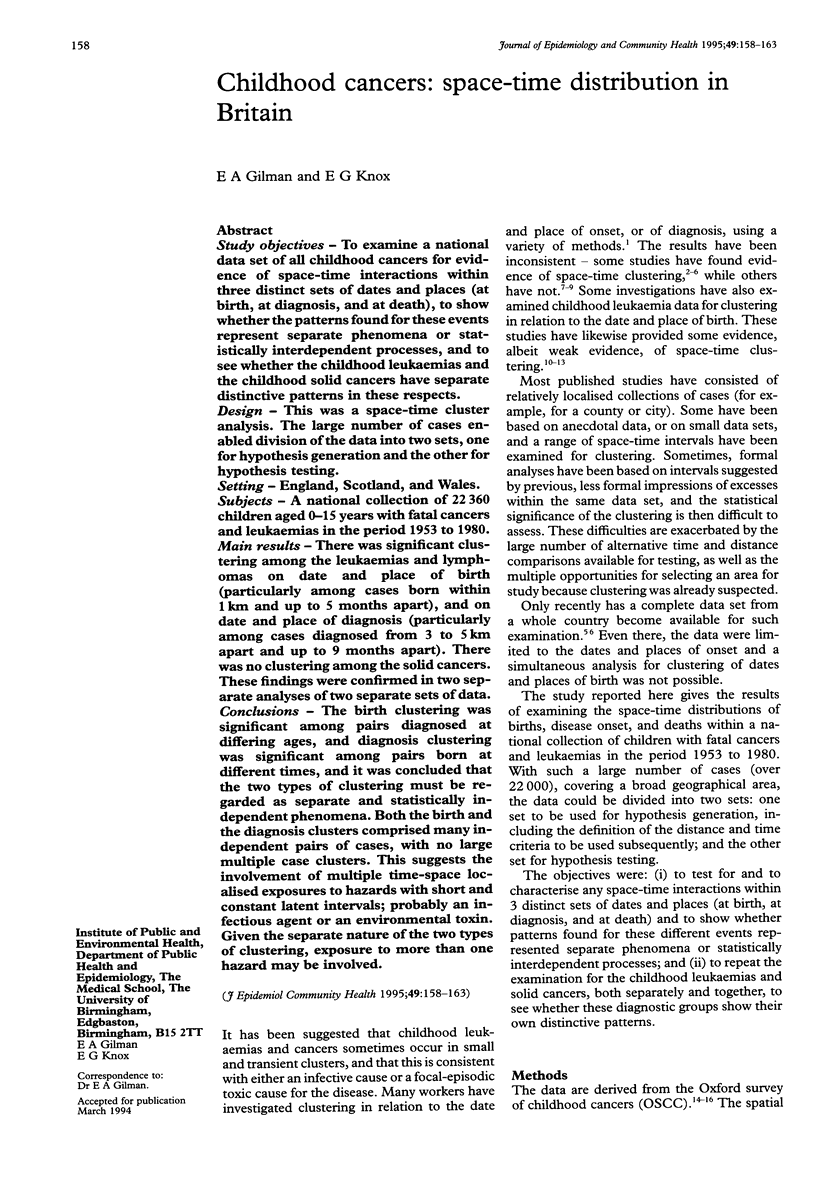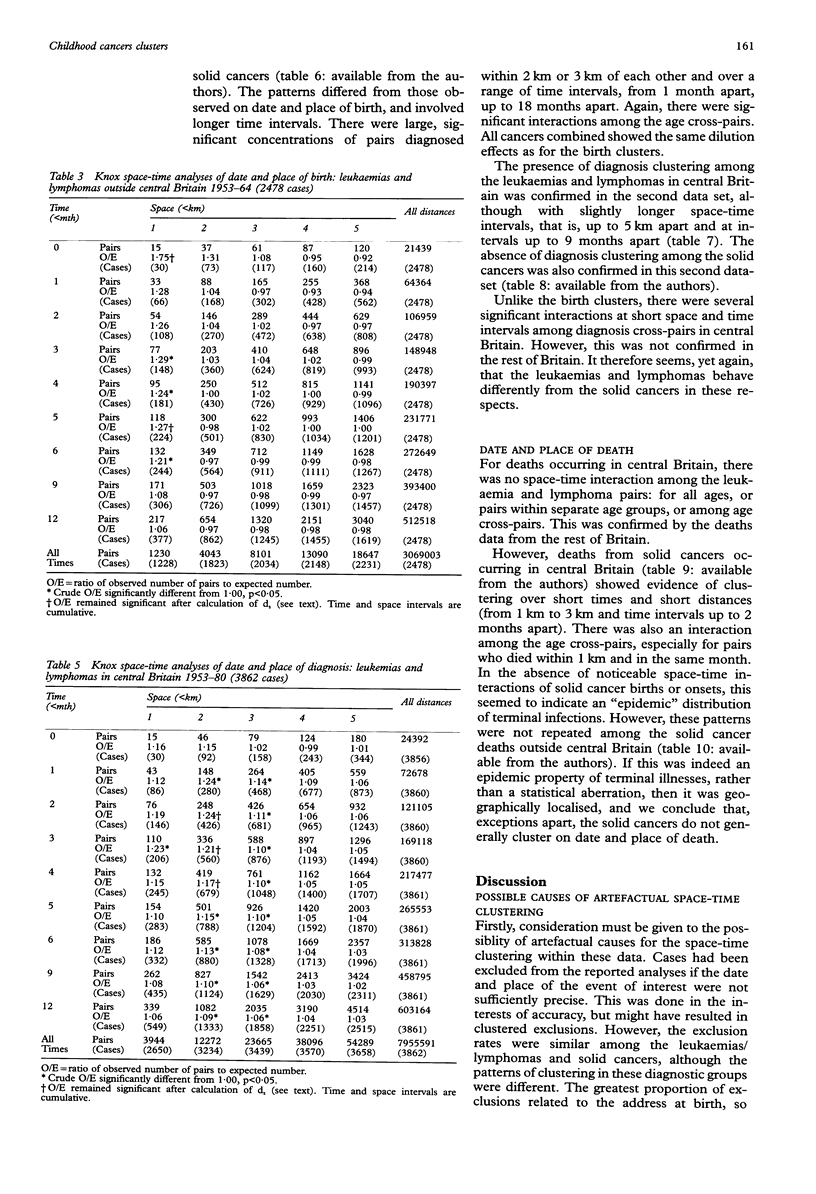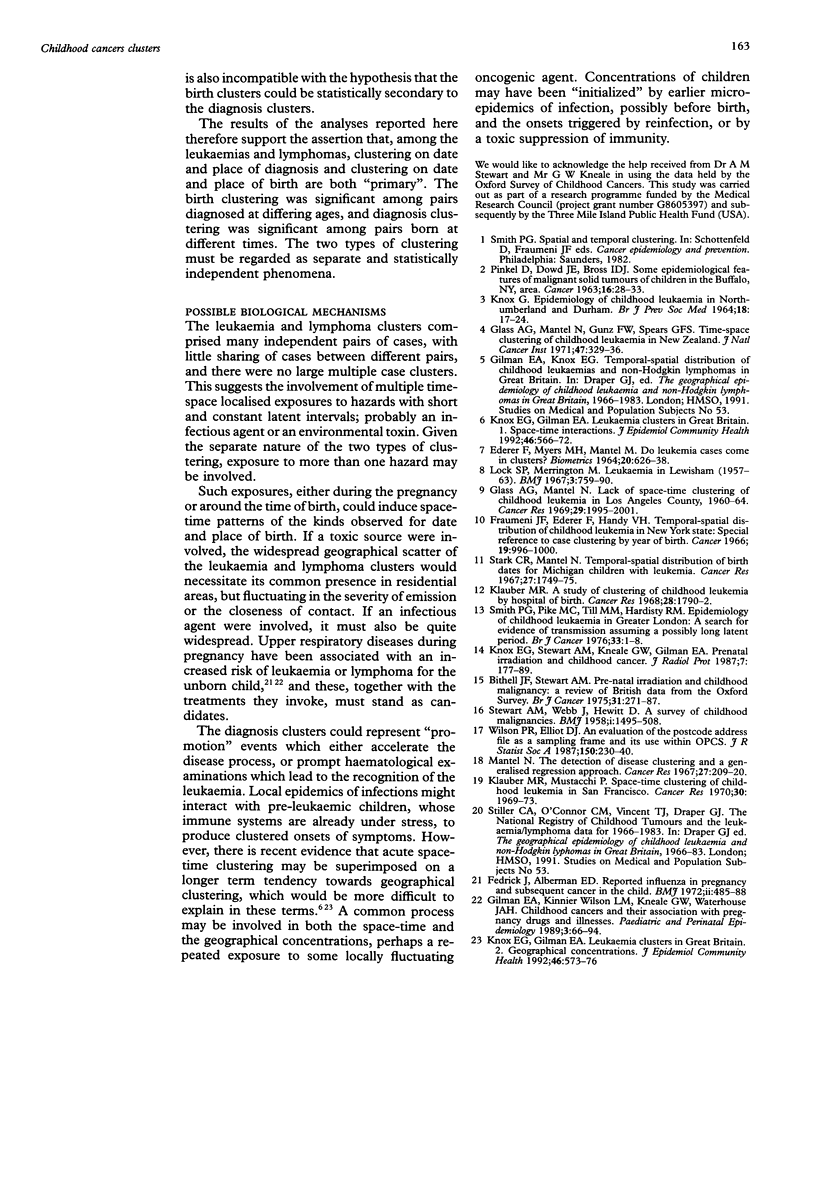Abstract
STUDY OBJECTIVES--To examine a national data set of all childhood cancers for evidence of space-time interactions within three distinct sets of dates and places (at birth, at diagnosis, and at death), to show whether the patterns found for these events represent separate phenomena or statistically interdependent processes, and to see whether the childhood leukaemias and the childhood solid cancers have separate distinctive patterns in these respects. DESIGN--This was a space-time cluster analysis. The large number of cases enabled division of the data into two sets, one for hypothesis generation and the other for hypothesis testing. SETTING--England, Scotland, and Wales. SUBJECTS--A national collection of 22,360 children aged 0-15 years with fatal cancers and leukaemias in the period 1953 to 1980. MAIN RESULTS--There was significant clustering among the leukaemias and lymphomas on date and place of birth (particularly among cases born within 1 km and up to 5 months apart), and on date and place of diagnosis (particularly among cases diagnosed from 3 to 5 km apart and up to 9 months apart). There was no clustering among the solid cancers. These findings were confirmed in two separate analyses of two separate sets of data. CONCLUSIONS--The birth clustering was significant among pairs diagnosed at differing ages, and diagnosis clustering was significant among pairs born at different times, and it was concluded that the two types of clustering must be regarded as separate and statistically independent phenomena. Both the birth and the diagnosis clusters comprised many independent pairs of cases, with no large multiple case clusters. This suggests the involvement of multiple time-space localised exposures to hazards with short and constant latent intervals; probably an infectious agent or an environmental toxin. Given the separate nature of the two types of clustering, exposure to more than one hazard may be involved.
Full text
PDF





Selected References
These references are in PubMed. This may not be the complete list of references from this article.
- Bithell J. F., Stewart A. M. Pre-natal irradiation and childhood malignancy: a review of British data from the Oxford Survey. Br J Cancer. 1975 Mar;31(3):271–287. doi: 10.1038/bjc.1975.62. [DOI] [PMC free article] [PubMed] [Google Scholar]
- Fedrick J., Alberman E. D. Reported influenza in pregnancy and subsequent cancer in the child. Br Med J. 1972 May 27;2(5812):485–488. doi: 10.1136/bmj.2.5812.485. [DOI] [PMC free article] [PubMed] [Google Scholar]
- Fraumeni J. F., Jr, Ederer F., Handy V. H. Temporal--spatial distribution of childhood leukemia in New York State. Special reference to case clustering by year of birth. Cancer. 1966 Jul;19(7):996–1000. doi: 10.1002/1097-0142(196607)19:7<996::aid-cncr2820190713>3.0.co;2-c. [DOI] [PubMed] [Google Scholar]
- Gilman E. A., Wilson L. M., Kneale G. W., Waterhouse J. A. Childhood cancers and their association with pregnancy drugs and illnesses. Paediatr Perinat Epidemiol. 1989 Jan;3(1):66–94. doi: 10.1111/j.1365-3016.1989.tb00371.x. [DOI] [PubMed] [Google Scholar]
- Glass A. G., Mantel N. Lack of time-space clustering of childhood leukemia in Los Angeles County, 1960-1964. Cancer Res. 1969 Nov;29(11):1995–2001. [PubMed] [Google Scholar]
- KNOX G. EPIDEMIOLOGY OF CHILDHOOD LEUKAEMIA IN NORTHUMBERLAND AND DURHAM. Br J Prev Soc Med. 1964 Jan;18:17–24. doi: 10.1136/jech.18.1.17. [DOI] [PMC free article] [PubMed] [Google Scholar]
- Klauber M. R. A study of clustering of childhood leukemia by hospital of birth. Cancer Res. 1968 Sep;28(9):1790–1792. [PubMed] [Google Scholar]
- Klauber M. R., Mustacchi P. Space-time clustering of childhood leukemia in San Francisco. Cancer Res. 1970 Jul;30(7):1969–1973. [PubMed] [Google Scholar]
- Knox E. G., Gilman E. Leukaemia clusters in Great Britain. 1. Space-time interactions. J Epidemiol Community Health. 1992 Dec;46(6):566–572. doi: 10.1136/jech.46.6.566. [DOI] [PMC free article] [PubMed] [Google Scholar]
- Knox E. G., Gilman E. Leukaemia clusters in Great Britain. 2. Geographical concentrations. J Epidemiol Community Health. 1992 Dec;46(6):573–576. doi: 10.1136/jech.46.6.573. [DOI] [PMC free article] [PubMed] [Google Scholar]
- Lock S. P., Merrington M. Leukaemia in Lewisham (1957-63). Br Med J. 1967 Sep 23;3(5568):759–760. doi: 10.1136/bmj.3.5568.759. [DOI] [PMC free article] [PubMed] [Google Scholar]
- Mantel N. The detection of disease clustering and a generalized regression approach. Cancer Res. 1967 Feb;27(2):209–220. [PubMed] [Google Scholar]
- STEWART A., WEBB J., HEWITT D. A survey of childhood malignancies. Br Med J. 1958 Jun 28;1(5086):1495–1508. doi: 10.1136/bmj.1.5086.1495. [DOI] [PMC free article] [PubMed] [Google Scholar]
- Smith P. G., Pike M. C., Till M. M., Hardisty R. M. Epidemiology of childhood leukaemia in greater london: A search for evidence of transmission assuming a possibly long latent period. Br J Cancer. 1976 Jan;33(1):1–8. doi: 10.1038/bjc.1976.1. [DOI] [PMC free article] [PubMed] [Google Scholar]
- Stark C. R., Mantel N. Temporal-spatial distribution of birth dates for Michigan children with leukemia. Cancer Res. 1967 Oct;27(10):1749–1755. [PubMed] [Google Scholar]


